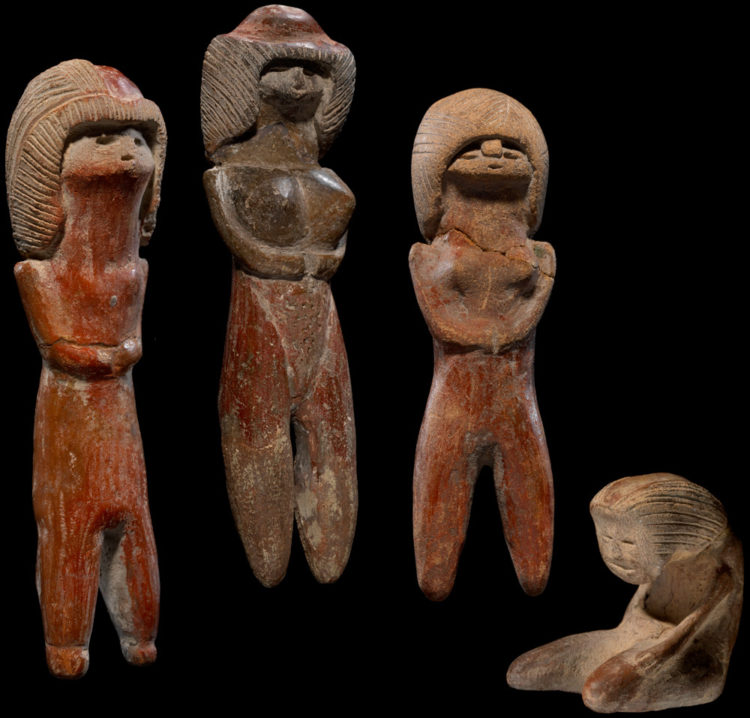
Valdivia female figurines, Valdivia, Guayas Province, Ecuador, c. 3500 BCE. National Museum of the American Indian. From Infinity of Nations: Art and History in the Collections of the National Museum of the American Indian exhibition.
These figurines are some of the oldest pottery in the Americas.
They were made by the Valdivia culture of South America around 3500 BCE. Depicting four women and measuring between 4 and 20 centimeters in height, each was modeled from a single block of clay, polished, and painted. They feature pronounced breasts, shoulders, and necks with raised heads, small faces, and elaborate hairstyles.
The Valdivia lived in small villages along the coast of modern-day Ecuador. They built single-family huts and the majority of their activities – including cooking, tool-making, and burials – took place in their villages. This means the Valdivia were very focused on their home lives.
The four figurines you see were found in contexts that suggest they were used in rituals. Found with other female figurines, some of which appear to be intentionally smashed, they might be part of shamanistic rituals, where the Valdivia transformed human figurines into holy objects. Modern-day rituals among South American tribes are similar, and women often dance and act as shamans in these rituals. Sometimes the rituals are agricultural and call for a good harvest or rains, and others are tied to life events like menstruation, pregnancy, and childbirth. Similar figurines have been found throughout Valdivia villages – in hearths, food preparation areas, burials, and trash piles – suggesting that the figurines were central to Valdivia life.
But what I find really fascinating is that these figurines depict real women and the power they held. Their elaborate hairstyles are very similar to how modern-day Andean women wear their hair. Additionally, scholars think that women were involved in Valdivia rituals as shamans, based on evidence found in Valdivia burials. The figurines were central to a shaman’s role, acting as a conduit to imbue with intentions for good rains or fertility. The emphasis on real depictions of women, their status as shamans, and the focus on home life suggests the Valdivia were a matrilineal society – or at least one in which women held considerable power.
We don’t know very much about the Valdivia. When sites related to them began to be excavated in the 1950s, looters quickly stepped in and took figurines and other artifacts like these. Locals began crafting fakes based off the looted objects, and sold them to archaeologists and tourists. Today, there are more Valdivia figurines in museums than were excavated by archaeologists – and it’s nearly impossible to tell the difference.
Are we looking at a fake? How do we know? These questions are central to archaeology, and the answers could call into question what we know about Valdivia women and the power they held.
– Tiffany Rhoades
Program Developer
Girl Museum, Inc.
This post is part of our 52 Objects in the History of Girlhood exhibition. Each week during 2017, we explore a historical object and its relation to girls history. Stay tuned to discover the incredible history of girls, and be sure to visit the complete exhibition to discover the integral role girls have played since the dawn of time.
For more on the Valdivia figurines and women in prehistoric America, check out the works of Karen Olsen Bruhns, including her book, Women in Ancient America (University of Oklahoma Press, 1999). You can view more Valdivia figurines at the Metropolitan Museum of Art.
